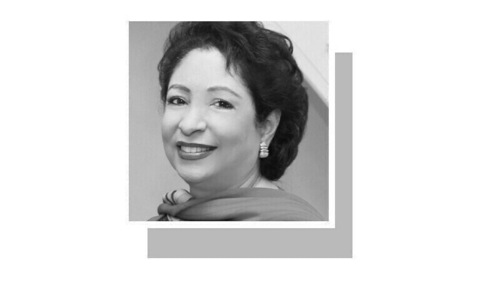LAHORE: A historian must consider all sources before making a factual statement, even if they are hopelessly in contradiction to each other. The historian must investigate like a detective. This is important to clear the dialogue between the past and present, said Romila Thapar while concluding her keynote address receiving a standing ovation by the audience on the first day of the third Lahore Literature Festival (LLF) on Friday.
Despite thunder and heavy rain, the people of Lahore pushed into the hall till the very end to listen to the expert on ancient India.
Take a look: LLF-2015: art features as a prominent theme
Introduced by Ayesha Jalal, Thapar spoke on the relationship between the past and the present, the role of historians in this context and how history has been affected by various sources.
“Current ideologies can be constructed on these investigations,” she said. “In fact, present ideologies that form a premise of the nation-state are now in need of reassessment and we must understand who we are, what we were and where we are going. Colonial thought process must be replaced by nurturing independent thought and investigation.”
Romila’s lecture revealed gaps in the history of the subcontinent. Referring to the historical incident of the Somnath temple, she said although various sources suggested it was indeed desecrated, the ramifications were layered and varied and far more complex than the popular narrative. And this narrative was the construct of colonial thought. Not until 1843 when a House of Commons member referred to this incident and stated it had traumatised Hindus and caused conflict and antagonism between the Hindus and Muslims did the historical event even come under discussion.
In fact, till the British conducted their first census, there was no concept of religious minorities and majority in the subcontinent. The census purely divided the people on the basis of their religious identity without taking sects into consideration. If this had been done, she said, the Bhakti-Sufi sects would have come up as a majority. Most people only followed the popular folk traditions and did not push religious identity till the colonial thought process pushed them to do so.
Third edition of literature festival gets under way
“Historical debates were initiated on changes in society and economy on culture and on the social function of religion,” Romila said. “As a result, perceptions of the relation between the past and present underwent spectacular change from the 1960s when history came to be written from these perspectives. Ancient history was no longer one long unchanging stretch of 3,000 years. Substantial variations were recognised within this time span. The Harappan cities flourished for a millennium and then declined. Yet our knowledge about their governments or religion is as yet intelligent guesses.”
Romila highlighted that a controversy over the origin of the Aryans could bring many important changes in society and politics today: were the authors of the Vedic texts from Central Asia, or eastern Iran and the borderlands, or were they indigenous?
“If they were indigenous, then it meant they were from within the borders of British India. Indian identity in those times was determined by cultural markers rather than political boundaries. There were no boundaries drawn on maps for the simple reason that maps did not exist. Borders were any way never permanent.”
The argument goes that if the Aryans were indigenous to India and that the Harappans were also Aryans then the Hindus who are Aryans have had an unbroken descent over 5000 years and can therefore claim priority in today’s citizenship. If they were not indigenous then it poses more challenging questions for the historian. How did the language of the Indo-Aryan come to be the dominant language given that there is evidence of other language speakers such as Dravidians co-existing?
Romila Thapar was among the historians who were hounded for presenting a secular history in the textbooks she wrote for middle and high schools. And she reflected it in her address at the LLF: “We maintained that the student must see the past from various aspects and the past can be investigated. Our textbooks were questioning the mythologies of popular historical narrative. So the books were only used up to four decades till 2005 and then attempts were made to have them proscribed and we fought that.”
She said fundamentalists of various hues were obviously unhappy with secular history that disallowed their mythologies.
Many of those who listened to her said they had acquired much food for thought.
“It was a pleasure to hear her speech and how the past can have a great dialogue with the present,” said Asif Farrukhi. “The historical evidence she presented on Somnath can give way to a lot of changes today.”
An Indian guest said Romila was always a joy to listen to and that she was impressed by the turnout.
A large number of people turned out at the Alhamra Art Centre on the Mall for the first day of the LLF which began amid elaborate security arrangements. They braved the skies, which cleared later in the day as if complimenting the spirit of the event and the liberating tone set by Romila’s lecture.
“This LLF is a very remarkable development. We need artistic literary intellectual debate and these are the fora which provide them,” said actor Salman Shahid.
Published in Dawn February 21th , 2015
On a mobile phone? Get the Dawn Mobile App: Apple Store | Google Play













































